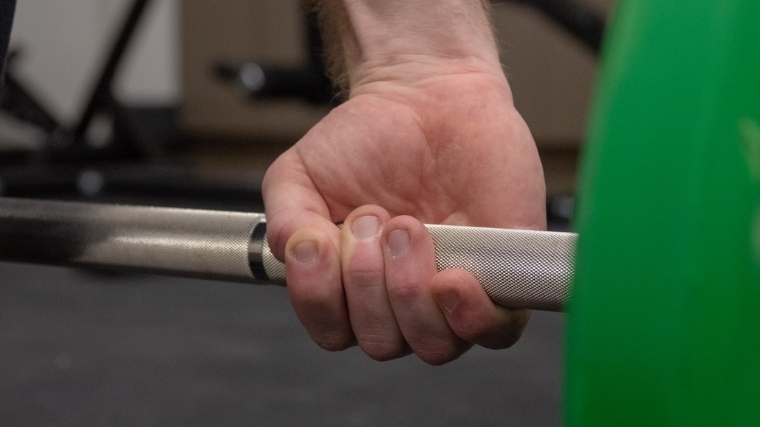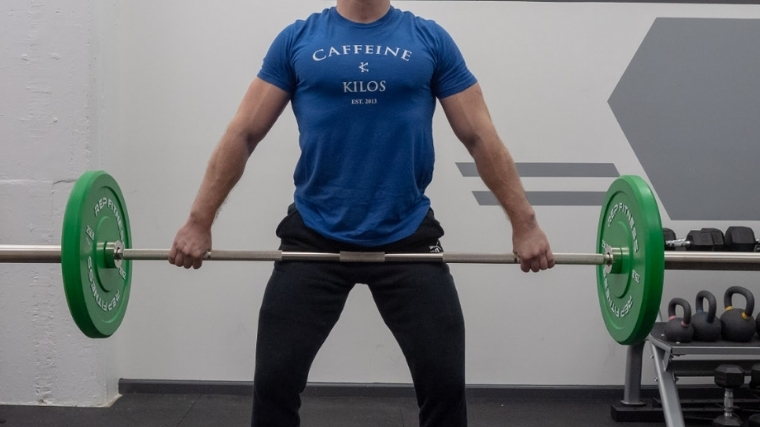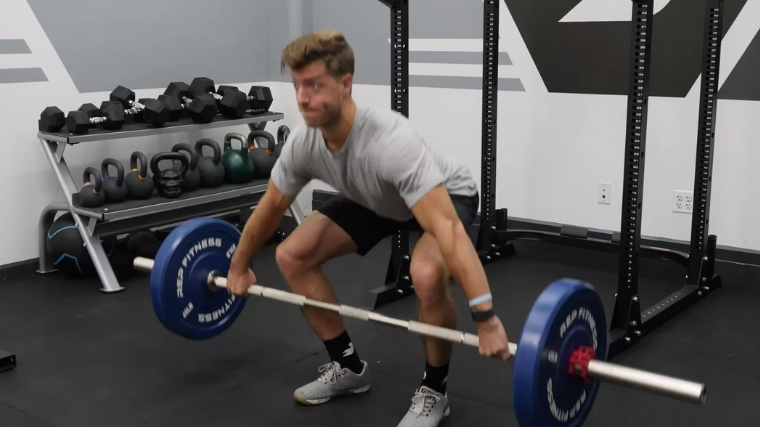The snatch-grip deadlift is a fantastic posterior chain dominant movement that possesses benefits for every type of athlete. Oftentimes, this exercise gets written off for only weightlifters, but every athlete can improve their performance by becoming stronger with snatch-grip deadlifts.
Outside of improving snatch mechanics and positioning, the snatch-grip deadlift also has carryover for improving grip strength and teaching patience off the floor when performing a traditional deadlift. If you’ve never tried snatch-grip deadlifts, then you’re in luck because this guide is designed to answer all of the questions you might have about this lift.
- How to Do the Snatch-Grip Deadlift
- Benefits of the Snatch-Grip Deadlift
- Muscles Worked by the Snatch-Grip Deadlift
- Snatch-Grip Deadlift Mistakes
- Who Should Do the Snatch-Grip Deadlift
- Snatch-Grip Deadlift Load Sets, Reps, and Programming Recommendations
- Snatch-Grip Deadlift Load Variations
- Snatch-Grip Deadlift Load Alternatives
- Frequently Asked Questions
Snatch-Grip Deadlift Video Guide
Check out the video below, featuring former BarBend Training Editor Jake Boly, for an in-depth and visual explanation on how to nail this strength- and muscle-building movement.
How to Do the Snatch-Grip Deadlift
The snatch-grip deadlift is best learned by breaking down the movement into specific steps. Check out the written guide below to nail the stance, grip, setup, and movement sequencing needed for this lift.
Step 1 — Establish Your Stance
Before setting for the snatch grip deadlift, achieve a slightly wider stance than your conventional deadlift stance and angle the feet out, splay the toes, and grip the floor.
Form Tip: Generally speaking, hip-width or just wider is a great stance starting point
Step 2 — Get a Grip
Assume your traditional snatch grip and ensure the hands are making full contact with the barbell. If the outside of the hand is coming off the barbell, then you’re gripping too wide.
Form Tip: If you can learn to hook grip, shown above, this will have great carry over to the snatch, as well as strengthen your grip on the bar.
Step 3 — Keep the Bar Close and lift
Before lifting the weight, go through a mental checklist and set the back bringing the hips to or just above parallel with the floor. Think about:
- Feet gripping the floor.
- Full hand contact on the barbell.
- Hips down and lower back set.
- Contract the lats and pull the bar in.
- Take a big belly breath and tighten your abs.
Form Tip: At the top of the deadlift, keep the lats contracted and the shoulder back. Squeeze the glutes and brace the torso for the eccentric.
Snatch-Grip Deadlift Benefits
It’s not the most common variation, but this deadlift has many benefits if you add it to your training program.
Posterior Chain Growth
Since the hips are set lower in the snatch-grip deadlift, the glutes and hamstrings will have to work exceptionally hard to produce strength and power. The hips are at disadvantageous leverage for this exercise, so the posterior will receive a ton of work to execute with perfect mechanics.
Patience Off the Floor
One of the most troublesome areas for regular deadlifts is having patience off the floor. Patience off the floor entails how you’re setting and contracting before physically lifting weight — a lot of it has to do with how slack is pulled out of the bar. Usually, an athlete’s hips rise too quickly, and that’s because they’re not patient in setting up.
Since the snatch-grip deadlift requires the hips to sit lower to be successful, athletes can carry over to their traditional deadlifts by learning to maintain a strong hip angle before initiation of weight, even though their mechanical positioning may be different.
Improved Snatch Posture
Most anyone can lift more with a snatch-grip deadlift than a standard snatch because you’re moving weight from the floor to hip level instead of overhead. Because you’re handling more weight in the start position of a snatch, you’ll learn to brace and maintain a straight back and a solid hip hinge in the initial pulling phase of the snatch. If you’re a lifter who struggles with the first part of the snatch, the snatch-grip deadlift can help fix your mechanics during this phase of the exercise.
Better Grip Strength
Olympic weightlifters don’t use lifting straps, and so most of them won’t wear any while performing this variation. The lack of straps alone will strengthen your grip. Also, the wide-arm position will put you at a mechanical disadvantage, making it harder to hold onto the bar.
Muscles Worked By the Snatch-Grip Deadlift
Below are the main muscle groups targeted when doing snatch grip deadlifts.
Hamstrings and Glutes
The snatch-grip deadlift specifically targets the hamstrings and glutes since the lifter is often in a more bent-over position than the conventional deadlift. In doing so, the lifter must use the hamstrings and glutes to extend the hips. This is a great variation for lifters who tend to round the back in the deadlift, as it will force a straighter back and, in turn, ramp up the demands on the hamstrings.
Back (Lats)
The snatch grip deadlift is a great back builder, as the wider grip forces the lifter to engage their lats during all phases of the pull. The wider grip can be used to help lifters who struggle with rounding their backs during the deadlift build a stronger back and maintain better deadlifting positions.
Erector Spinae (Lower Back)
The erectors (also known as the lower back muscles) are muscle groups targeted during the snatch-grip deadlift. The wide grip forces lifters to focus on keeping the back flat and holding a neutral or slightly extended position, which will increase muscle growth and the demands placed upon the erectors.
Snatch-Grip Deadlift Mistakes
The snatch-grip deadlift is a technical movement. Here are two common mistakes and ways to correct them.
Incorrect Grip Width
If you’re an Olympic weightlifter, then chances are good you’ll have no trouble finding the right grip for snatch-grip deadlifts. After all, it’s the same grip you use to snatch with. For non-weightlifters, it may be a bit tougher. If you notice that the pinky and fourth digit’s knuckles lose contact with the bar, then your grip is probably off.
The Solution: If you’ve never performed a snatch or snatch variation, then finding your perfect grip can be confusing. An easy way to find your baseline snatch grip is by taking a dowel, broomstick, or other implement and performing the drill below. Don’t use a barbell for this drill — it’s too heavy.
- Grip the implement with the hands making full contact.
- Bring one arm directly up and think “biceps to ear.”
- Bring the other arm to a position that’s parallel to the floor and think, “create a 90-degree angle”.
- To get this perfectly right, have a coach or friend help with your 90-degree angle.
Generally, this will be the best starting point for lifters trying to find their perfect snatch grip width. Once you think you have it, play around with grip width slightly to see what’s comfortable for you.
Hips Rise Too Quickly
If the hips are rising too quickly, then two things can happen. First, you’re putting your lower back at risk of injury, and two, your reps won’t be efficient.
The Solution: A great snatch-grip deadlift is often the result of great hip sequencing. At the top of the movement, think about pushing the hips back while maintaining a rigid torso. The barbell should not ramp down the legs, as this can cause a weight shift forward, resulting in poor movement mechanics. If you find that your bar path is a little out of line, then try setting two foam rollers in line with another at the very end of the barbell, about eight to 10 inches apart. Ideally, the barbell should not make contact or knockdown either of the foam rollers during both the concentric and eccentric movement phases.
Who Should Do the Snatch-Grip Deadlift
Below are some reasons why strength, power, and fitness athletes may benefit from performing the snatch-grip deadlift.
Strength and Power Athletes
- Strongman athletes can use the snatch-grip deadlift to improve back and grip strength. The snatch-grip deadlift can also add variety to pulling movements and help further diversify pulling and gripping strength.
- Powerlifters will benefit from adding the snatch-grip deadlift into training for similar reason strongman athletes. Snatch-grip deadlifts also address breakdowns in back tension and strength during a deadlift. Due to the wider grip taken, the lifter must have a stronger back to resist the upper back and spine flexion during the pull.
- Olympic weightlifters can use the snatch-grip deadlift as one of their primary pulling variations for strength, as it has direct application to the snatch. Using the snatch-grip deadlifts in programs can help increase the pulling, back, and grip strength necessary for stronger snatch and clean & jerk positions.
Fitness Athletes and General Fitness
Anyone else can benefit from snatch-grip deadlifts for the reasons listed above. Perform this deadlift variation as your main pulling movement, or perform a few lighter sets at the end of a back or pull-focused training session.
Snatch-Grip Deadlift Sets, Reps, and Programming Recommendations
Here are three ways to add snatch-grip deadlifts to your training.
To Build Muscle
Formore muscle, perform three to five sets of five to 12 repetitions, resting 60-90 seconds between sets, with heavy to moderate loads (60-80% of your one-rep max). It is important to note that muscle hypertrophy can still occur (and often does, even with more advanced lifters) with high load, lower repetition training.
To Improve Strength
For general strength-building sets, athletes can perform lower repetition ranges for more sets. Try performing three to six sets of two to five repetitions with 80-95% of your one-rep max. Rest for two to three minutes between sets.
To Improve Snatch Technique
While the snatch-grip deadlift is specific to the snatch, many lifters will lift too heavy and turn the snatch grip deadlift into a pull that doesn’t translate over to the actual snatch (hips shoot up, back rounds, etc.). Aim to perform three to five sets with 100-120% of snatch max, using tempos, pauses, and from a deficit.
Snatch-Grip Deadlift Variations
Below are two snatch grip deadlift variations that can help improve technique, strength, and performance in the deadlift, snatch, and snatch grip deadlift
Deficit Snatch-Grip Deadlift
The deficit snatch grip deadlift is done by performing the standard snatch grip deadlift, but from a slight deficit (anywhere between two to four inches). A deficit deadlift increases the range of motion of the exercise, making the lifter stronger when they go back to a shorter ROM, and it also increases pulling power from the floor.
Snatch-Grip Deadlift with Pause in Pull
Pausing during any point of the snatch-grip deadlift will help to strengthen that specific range of motion. If you are weak off of the ground, pause at your shins. If you have trouble locking out the weight, then pause at the thighs.
Snatch-Grip Deadlift Alternatives
Below are three snatch-grip deadlift alternatives coaches and athletes can use to improve strength and performance, similar to when the snatch grip deadlift is performed.
Clean-Grip Deadlift
A clean deadlift looks like a conventional deadlift, but it has the lifter lower their hips lower (as if they’re initiating a clean & jerk) and taking the same grip they’d use for any clean variation. It’s the other most popular weightlifting-specific deadlift.
Snatch-Grip Bent-Over Row
The wide-arm grip better targets the lats and upper back muscles while also preparing the body specifically to do snatch-grip deadlifts or the snatch.
Snatch-Grip Romanian Deadlift
The snatch-grip Romanian deadlift reinforces lat strength and proper back position during the Romanian deadlift. Often, lifters will allow their backs to round out during RDLs, which can lead to injury and minimize the stretch and loading placed upon the hamstrings. A wider grip forces better positioning and helps promote muscle hypertrophy.
FAQs
How wide should I grip during the snatch-grip deadlift?
Generally speaking, your grip should be taken at the same spot you snatch from. If you don’t snatch, then set your grip so it rests at the hip crease and not on the thighs when the barbell is lifted. If it is resting on the thighs, you need to widen your grip.
Are snatch grip deadlifts easier or harder than conventional deadlifts?
Snatch-grip deadlifts are more difficult for most people when compared to conventional deadlifts as the wider grip forces greater demands on the forearms, lats, and erectors to maintain a long torso and non-rounded position.
How do I know if I shouldn't do the snatch-grip deadlift?
If you can’t perform a standard deadlift then steer clear of snatch-grip deadlifts. While they are not harmful to most individuals and often force better positions if people don’t lift too heavy, it still places a good amount of stress and strain on the lower back muscles and hips, making them contradictory to anyone who has lower back issues.



